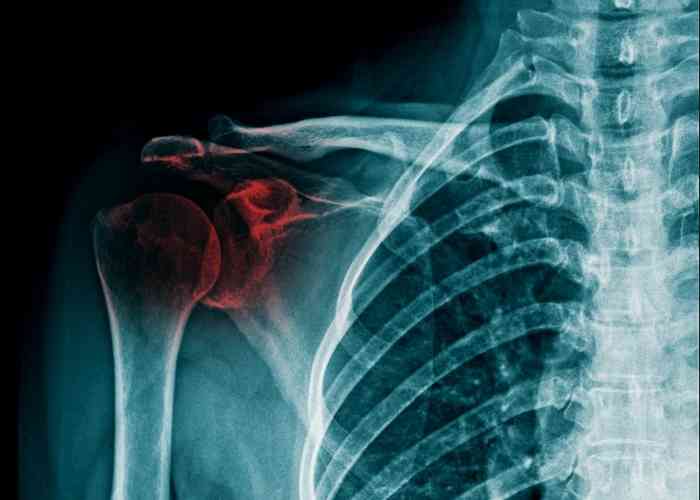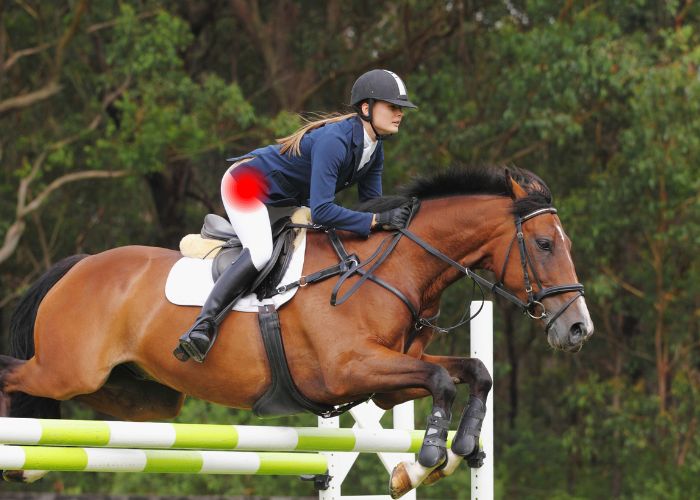What is a shoulder fracture?
A shoulder fracture occurs when one, or more, of the three major shoulder bones is broken: the proximal humerus (top of the upper arm bone), the scapula (shoulder blade), or the clavicle (collarbone).

Proximal Humerus Fracture
The humerus is the upper arm bone found between the apex of the shoulder and the elbow. A fracture to the top portion of this bone is often caused by a traumatic event, such as a motor vehicle collision, a fall, or a direct blow with athletic activities. Other injuries such as soft tissue damage, cartilage tears, and additional bone fractures frequently occur with a proximal humerus fracture. Individuals with a proximal humerus fracture commonly report severe pain, substantial swelling of the shoulder girdle, and significantly reduced shoulder movement.
Scapula Fracture
A scapular fracture is a rare condition that only accounts for less than 1 percent of adult broken bones as this triangular-shaped bone is protected by the chest and a complex network of surrounding muscles. A fracture of the scapula is often the consequence of high-energy traumas, such as a fall from a significant height or a high-speed motor vehicle collision. Due to the amount of force required to break the scapula, this condition is often accompanied by other major injuries such as a head injury, damage to the lungs, or a spinal cord injury. Some common complaints of a scapular fracture are severe pain with arm movement, swelling and/or bruising to the posterior shoulder, and skin abrasions over the posterior shoulder.
Clavicle Fracture
A clavicle fracture is often the result of a direct blow to the clavicle or falling onto an outstretched arm and typically affects the middle portion of this long bone. Athletes involved in aggressive contact sports such as wrestling or football, however, have a greater likelihood of experiencing a clavicle fracture. Some common indicators of a clavicle fracture are tenderness and/or swelling near the fracture site, an obvious visual deformity of the clavicle, and forward or downward sagging of the shoulder girdle. Dr. Ronak Mukesh Patel, orthopedic shoulder specialist serving patients in Sugar Land, Pearland, and the Houston, Texas area, has the knowledge and understanding, as well as substantial experience, in treating patients with a shoulder fracture.
Are certain populations more at risk for a shoulder fracture?
Although shoulder fractures are primarily caused by traumatic events, there are certain groups of individuals that are more vulnerable to experiencing a shoulder fracture. Children and teens are susceptible due to the lower bone density found during the peak growth stages between 10 and 19. Older adults can sustain a shoulder fracture from a minor injury due to the natural decline of bone density with aging. Because the majority of shoulder fractures occur from a traumatic event, athletes involved in aggressive or high-impact sports are the most at risk of developing a shoulder fracture.
How is a shoulder fracture diagnosed?
A complete medical history, including any precipitating injuries and any other underlying shoulder conditions, is gathered by Dr. Patel. This interview is followed by a thorough physical examination to assess the extent of damage and evaluate for pain, tenderness, and range of motion. Diagnostic imaging studies are useful in confirming a shoulder fracture diagnosis. X-rays can identify the fracture site and any other bone-related damage. Magnetic resonance imaging (MRI) can further assess the extent of damage and also identify any damage to the other shoulder girdle structures.
What is the treatment for a shoulder fracture?
Non-surgical treatment:
Non-surgical therapy options are recommended for patients with non-displaced shoulder fractures. A sling or other immobilization device is applied to realign the shoulder girdle and prevent any further damage. A combination of rest, ice, and non-steroidal anti-inflammatory medications (NSAIDs) can also be useful in minimizing any pain and inflammation. When appropriate, shoulder girdle strengthening through a physical therapy program may be recommended as well.
Surgical treatment:
If non-surgical therapies failed or the fracture resulted in bone displacement, surgical intervention is often necessary to realign the bone fragments and reduce the risk of early-onset arthritis. Surgical reconstruction of a shoulder fracture is completed through open reduction and internal fixation (ORIF) utilizing special plates, pins, and/or screws.
Broken Shoulder Specialist

Three major bones within the shoulder can be fractured or can break from a hard fall, accident, or from playing contact sports. Shoulder fractures often involve other damage to the support tissues, tendons, and muscles of the shoulder. Shoulder fracture specialist, Doctor Ronak Mukesh Patel, provides diagnosis as well as surgical and nonsurgical treatment options for patients in Houston, Sugar Land, and Pearland, TX who have suffered a shoulder fracture or broken shoulder. Contact Dr. Patel’s team today!








